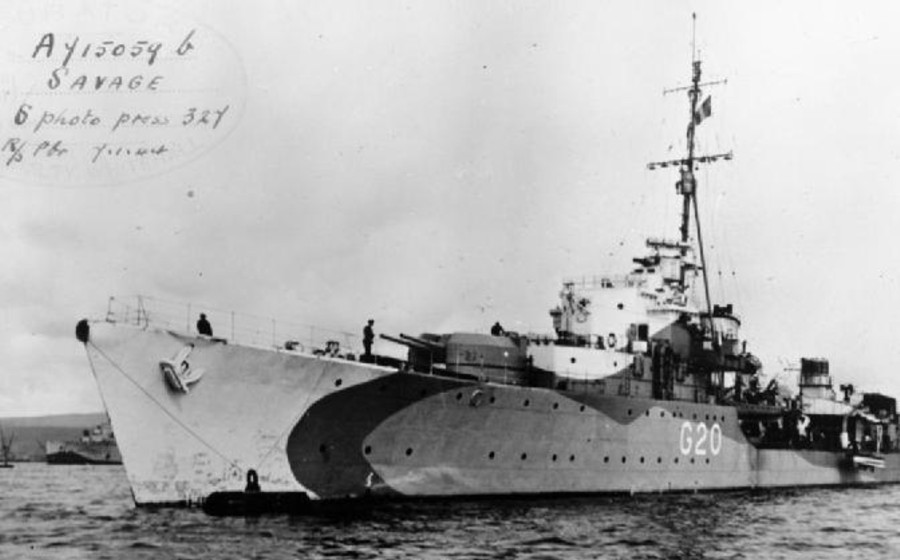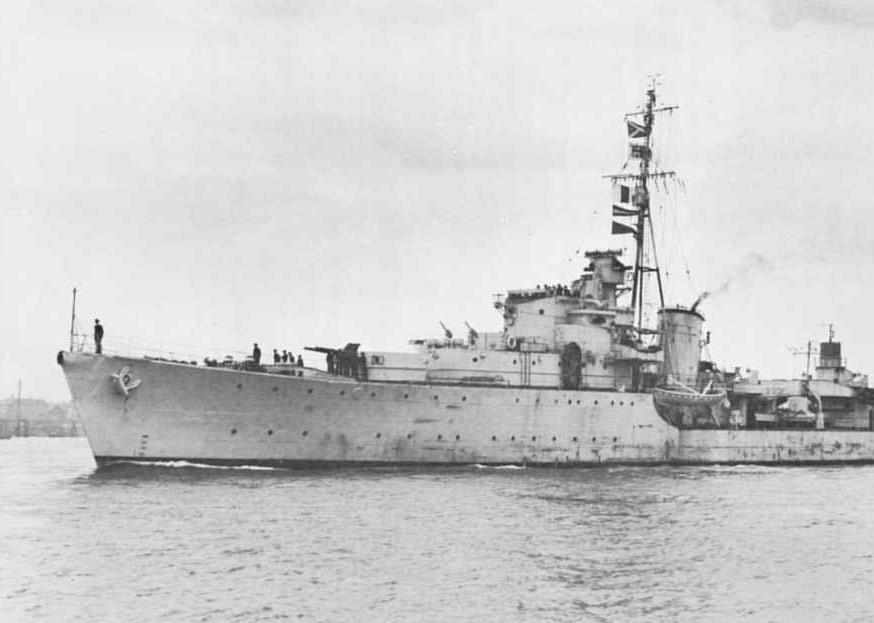
"Ca" (or 11th Emergency) Flotilla
This flotilla was authorised under the 1941 Programme. The first pair was ordered from Yarrow on 16 February 1942; the other six were ordered on 24 March, a pair each from John Brown, Scotts and Cammell Laird. However, on 12 August 1942 the contract for the last pair was moved from Cammell Laird to White. Their originally-allocated names were altered to new names beginning with "Ca-" in November 1942. The John Brown pair - Caesar and Cavendish - were fitted as Leaders.
On completion they formed the 6th Destroyer Flotilla for service in the Home Fleet. At the end of the war in Europe the flotilla was transferred to the East Indies Fleet and the ships arrived on station between August and November 1945, too late to see service against Japan. They remained in the Indian Ocean until May 1946 when they returned home and paid off into operational reserve.
| Name | Pennant | Builder | Laid Down | Launched | Commissioned | Fate |
|---|---|---|---|---|---|---|
| Caprice (ex-Swallow) | R01 later D01 |
Yarrow, Scotstoun | 28 September 1942 | 16 September 1943 | 5 April 1944 | Modernised by Yarrow 1959. Paid off March 1973. Scrapped 1979 at Queenborough. |
| Cassandra (ex-Tourmaline) | R62 later D10 |
Yarrow, Scotstoun | 3 January 1943 | 29 November 1943 | 28 July 1944 | Modernised by Yarrow 1960. Paid off January 1966. Scrapped at Inverkeithing in 1967. |
| Caesar* (ex-Ranger) | R07 later D07 |
John Brown, Clydebank | 3 April 1943 | 14 February 1944 | 5 October 1944 | Modernised 1957-60 at Rosyth. Paid off June 1965. Scrapped 1967 at Blyth. |
| Cavendish* (ex-Sibyl) | R15 later D15 |
John Brown, Clydebank | 19 May 1943 | 12 April 1944 | 13 December 1944 | Modernised 1956. Laid up 1964. Scrapped 1967 at Blyth. |
| Cambrian (ex-Spitfire) | R85 later D85 |
Scotts, Greenock | 14 August 1942 | 10 December 1943 | 14 July 1944 by John Brown |
Modernised 1963. Paid off December 1968. Scrapped 1971 at Briton Ferry. |
| Carron (ex-Strenuous) | R30 later D30 |
Scotts, Greenock | 26 November 1942 | 28 March 1944 | 6 November 1944 | Modernised August 1955 as Training Ship. Paid off
March 1963. Scrapped 1967 at Inverkeithing. |
| Cavalier (ex-Pellew) | R73 later D73 |
White, Cowes | 28 February 1943 | 7 April 1944 | 22 November 1944 | Modernised 1957. Paid off July 1972. Sold October 1977 to be preserved as a museum ship, since 1999 preserved at Chatham Historic Dockyard, Kent. |
| Carysfort (ex-Pique) | R25 later D25 |
White, Cowes | 12 May 1943 | 25 July 1944 | 20 February 1945 | Modernised 1956. Paid off February 1969. Scrapped 1970 at Newport. |
"Ch" (or 12th Emergency) Flotilla
Six destroyers, the first of 26 'Intermediate' destroyers to be authorised under the 1942 Programme, were ordered on 24 July 1942, a pair each from Thornycroft, Scotts and Alexander Stephen. The fourth pair was originally intended to be ordered from Vickers Armstrongs, Walker-on-Tyne, but instead were ordered from Denny on 30 July. The Chequers and Childers were fitted as Leaders.
| Name | Pennant | Builder | Laid Down | Launched | Commissioned | Fate |
|---|---|---|---|---|---|---|
| Chaplet | R52 | Thornycroft, Woolston | 29 April 1943 | 18 July 1944 | 24 August 1945 | Laid up 1961. Sold for scrapping 1965. |
| Charity | R29 | Thornycroft, Woolston | 9 July 1943 | 30 November 1944 | 19 November 1945 | Transferred to Pakistan Navy as Shah Jehan 16 December 1958, irreparably damaged by Indian Navy warships off Karachi 4 December 1971 and scrapped as a result |
| Chequers * | R61 | Scotts, Greenock | 4 May 1943 | 30 October 1944 | 28 September 1945 | Laid up 1964, scrapped 1966. |
| Chieftain | R36 | Scotts, Greenock | 27 June 1943 | 26 February 1945 | 7 March 1946 | Scrapped 1961. |
| Chevron | R51 | Alex. Stephen, Linthouse | 18 March 1943 | 23 February 1944 | 23 August 1945 | Accommodation ship at Rosyth, scrapped 1969. |
| Cheviot | R90 | Alex. Stephen, Linthouse | 27 April 1943 | 2 May 1944 | 11 December 1945 | Harbour training ship at Rosyth 1960. Sold for scrapping 1962. |
| Childers * | R91 | Denny, Dumbarton | 27 November 1943 | 27 February 1945 | 19 December 1945 | Laid up 1958. Sold for scrapping 1963. |
| Chivalrous | R21 | Denny, Dumbarton | 27 November 1943 | 22 June 1945 | 13 May 1946 | Transferred to Pakistan Navy on 29 June 1954 as Taimur, scrapped 1961. |
.jpg)
A lot of the war emergency
destroyers were converted to type 15 and 16 frigates to get the
most out of them until enough of the Leander class frigates
entered service.
"Co" (or 13th Emergency) Flotilla
The first four of these destroyers were ordered in August 1942 - Comus and Concord on 7th, Contest on 12th and Consort on 14th. The remaining four destroyers were ordered on 12 September; Constance and Cossack were fitted as Leaders.
| Name | Pennant | Builder | Laid Down | Launched | Commissioned | Fate |
|---|---|---|---|---|---|---|
| Comus | R43 | Thornycroft | 21 August 1943 | 14 March 1945 | 8 July 1946 | Sold for scrapping 1958. |
| Concord (ex-Corso) | R63 | Thornycroft | 18 November 1943 | 14 May 1945 | 20 December 1946 | Harbour Training Ship Rosyth. Sold for scrapping 1962 |
| Contest | R12 (later D48) | White | 1 November 1943 | 16 December 1944 | 9 November 1945 | Sold for scrapping 1962 |
| Consort | R76 | Stephen | 26 May 1943 | 19 October 1944 | 19 March 1946 | Sold for scrapping 1961 |
| Cockade | R34 | Yarrow | 11 March 1943 | 7 March 1944 | 29 September 1945 | Paid off 1958. Sold for scrapping 1964. |
| Comet | R26 | Yarrow | 14 June 1943 | 22 June 1944 | 6 June 1945 | Paid off 1958. Sold for scrapping 1962. |
| Constance* | R71 | Vickers Armstrongs, Walker | 18 March 1943 | 22 August 1944 | 31 December 1945 | Sold for scrapping 1956. |
| Cossack* | R57 | Vickers Armstrongs, Walker | 18 March 1943 | 10 May 1944 | 4 September 1945 | Sold for scrapping 1961. |

"Cr" (or 14th Emergency) Flotilla
All eight destroyers were ordered on 12 September 1942, two each from John Brown, Yarrow, White and Scotts; the John Brown pair - Crescent and Crusader - were fitted as Leaders.
Original drawings on even older drawings, execution needed a bit
of work.
_1945.jpg)
